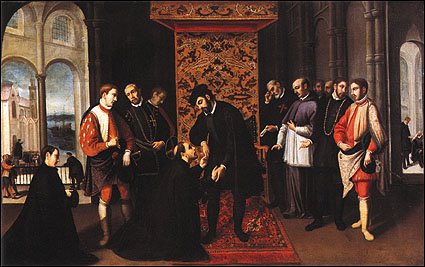Goa Inquisition: The Horrors That Were Unleashed Upon Hindus


The Goa Inquisition was the office of the Inquisition acting in the Indian state of Goa and the rest of the Portuguese empire in Asia. It was established in 1560, briefly suppressed from 1774-1778 and then abolished in 1812. The aim of this Inquisition was to establish Catholic faith and suppress Indian Catholics and Hindus by confiscating all their rights and properties.
This Inquisition is regarded by all contemporary portrayals as the most violent and horrific inquisition ever executed by the Portuguese Catholic Church. The proceedings of the Inquisition always took place behind closed shutters and closed doors. The screams of agony of the men, women and children as culprits could be heard on the streets, in the stillness of the night, as they were brutally interrogated, flogged and slowly dismembered in front of their relatives.

Eyelids were sliced off, extremities were amputated carefully, a person could remain conscious even though the only thing that remained was his torso and head.
Diago de Boarda, a priest and his advisor Vicar General, Miguel Vazz made a 41-point plan for torturing Hindus.
According to the order, construction of Hindu temples was prohibited. For already constructed temples, no repair work would be carried out without the King’s permission. If this order was transgressed, such temples would be destroyed and the goods in them would be used to meet expenses of Holy deeds of the Church.
Under the issued Fatva, Hindus of Goa were prohibited from following rituals:
Prohibitions regarding religious rituals
Prohibitions regarding marriages
By 1540, all Hindu temples were destroyed, the murthis annihilated and their sites and building material was utilized to erect new Christian Churches & chapels.
Judicial use of “Torture” by the Inquisition

Torture was used by the Inquisition as an expedient to obtain a confession where the evidence against the accused was incomplete, defective or conflicting.
There were two kinds of tortures mainly,


You name it and it was there. Women were subjected to even worse tortures; you can imagine what they were like.
The Archbishop of Avera, Portuguese Archbishop had remarked in a speech that the Inquisitors went to the length of imprisoning in his jail, women who resisted their advances and after having satisfied their bestial instincts, ordering that they may be burnt at stakes as heretics. The worse torture, the final torture was of course burning them alive at public events called Auto da fe, meaning ‘trial by fire’.

These Auto da fe’s were held once a year or maybe once every two years, where people who had not confessed and people who were convicted of heretical crimes were actually burnt alive at stakes.
On September 22, 1570 an order was issued that:
“ The Hindus embracing Christianity will be exempted from land taxes for a period of 15 years and that nobody shall bear Hindu names and surnames. “
Such brutal were the horrors of the Portuguese Inquisition, yet nothing was ever done to stop this notoriety and escalating barbarity and it continued for 200 more years.
The entire history of the barbarism by the Portuguese has been erased and finds just a brief mention in the school textbooks while shamelessly glorifying the Portuguese. Catholics of Goa swear by the Portuguese and boast of their superiority till date. No wonder St. Francis Xavier is still worshipped and looked up as the savior of Goan soil by both Hindus and Catholics of Goa. Utter Shame!
Today, when I walk the roads of Goa, visit its temples and witness the rich Hindu culture of Goa, I can only deeply wonder how it could be possible for a state that went through such brutal atrocities to still be left with so much warmth, color and cultural abundance. Perhaps, it is rightly said so,
“This is the Parashuram Bhoomi– the Land of Shri Parashuram” and nothing can erase this identity of Goa.
Sources:- 1) www.indiafacts.org
2) Goa Inquisition- Anant Priolkar
DISCLAIMER: The author is solely responsible for the views expressed in this article. The author carries the responsibility for citing and/or licensing of images utilized within the text.
